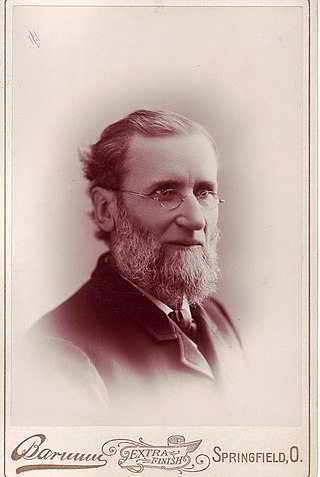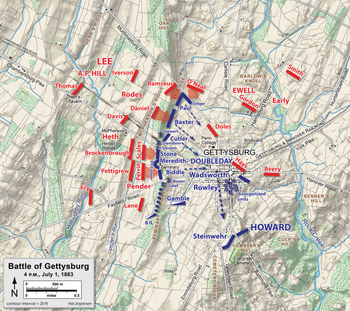
Gettysburg is a borough and the county seat of Adams County in the U.S. state of Pennsylvania. The Battle of Gettysburg (1863) and President Abraham Lincoln's Gettysburg Address are named for this town.

Wilhelm Sihler was a German American Lutheran minister. A proponent for Christian education, Wilhelm Sihler founded Concordia Theological Seminary, in Fort Wayne, Indiana.
The Lutheran Church in America (LCA) was an American and Canadian Lutheran church body that existed from 1962 to 1987. It was headquartered in New York City and its publishing house was Fortress Press.

Seminary Ridge is a dendritic ridge which was an area of Battle of Gettysburg engagements in July 1863 during the American Civil War (1861–1865), and of military installations during World War II (1941–1945).

Samuel Simon Schmucker was a German-American Lutheran pastor and theologian. He was integral to the founding of the Lutheran church body known as the General Synod, as well as the oldest continuously operating Lutheran seminary and college in North America.

Daniel Alexander Payne was an American bishop, educator, college administrator and author. A major shaper of the African Methodist Episcopal Church (A.M.E.), Payne stressed education and preparation of ministers and introduced more order in the church, becoming its sixth bishop and serving for more than four decades (1852–1893) as well as becoming one of the founders of Wilberforce University in Ohio in 1856. In 1863 the AME Church bought the college and chose Payne to lead it; he became the first African-American president of a college in the United States and served in that position until 1877.

Charles Porterfield Krauth was a pastor, theologian and educator in the Lutheran branch of Christianity. He is a leading figure in the revival of the Lutheran Confessions connected to Neo-Lutheranism in the United States.

The Lutheran Theological Seminary at Philadelphia (LTSP), also known as the Philadelphia Seminary, was one of eight theological seminaries associated with the Evangelical Lutheran Church in America, the largest Lutheran denomination in North America. It is located on Germantown Avenue in the Mount Airy neighborhood of northwestern Philadelphia. Founded in 1864, it has its roots in the Pennsylvania Ministerium established in 1748 in Philadelphia by Henry Melchior Muhlenberg.

John Christian Frederick Heyer was the first missionary sent abroad by Lutherans in the United States. He founded the Guntur Mission in Andhra Pradesh, India. "Father Heyer" is commemorated as a missionary in the Calendar of Saints of the Lutheran Church on November 7, along with Bartholomaeus Ziegenbalg and Ludwig Ingwer Nommensen.

The Pennsylvania Ministerium was the first Lutheran church body in North America. With the encouragement of Henry Melchior Muhlenberg (1711–1787), the Ministerium was founded at a Church Conference of Lutheran clergy on August 26, 1748. The group was known as the "German Evangelical Lutheran Ministerium of North America" until 1792, when it adopted the name "German Evangelical Lutheran Ministerium of Pennsylvania and Adjacent States".
The Evangelical Lutheran General Synod of the United States of America, commonly known as the General Synod, was a historical Lutheran denomination in the United States. Established in 1820, it was the first national Lutheran body to be formed in the U.S. and by 1918 had become the third largest Lutheran group in the nation. In 1918, the General Synod merged with other Lutheran denominations to create the United Lutheran Church in America. Both the General Synod and the United Lutheran Church are predecessor bodies to the contemporary Evangelical Lutheran Church in America.

Horatio Stockton Howell was a Union Army chaplain killed in downtown Gettysburg on the first day of the Battle of Gettysburg in the American Civil War.

Luther Alexander Gotwald, D.D. was a professor of theology in the Wittenberg Theological Seminary in the United States. He was tried for heresy by the board of directors at Wittenberg College in Springfield, Ohio, on April 4 and 5, 1893, which put on trial many key issues that Lutherans still debate today.
John George Schmucker was a German-American Lutheran clergyman.

Schmucker Hall is an American Civil War site listed on the National Register of Historic Places in Adams County, Pennsylvania, that was constructed as the original Gettysburg Theological Seminary building. Used as both a Union and Confederate hospital during the 1863 Battle of Gettysburg, the facility served as the seminary's main building from 1832 to 1895, then as a dedicated dormitory for students until 1951. In 1960, it was leased by the Adams County Historical Society. Beginning in 2006, the Historical Society, along with the Seminary Seminary Ridge Historic Preservation Foundation, rehabilitated the building for adaptive reuse as the Seminary Ridge Museum. The Adams County Historical Society moved into the nearby Wolf House on the seminary campus preceding the renovation. In 2013, on the 150th anniversary of the battle, the Seminary, the Adams County Historical Society and the Seminary Ridge Historic Preservation Foundation opened the building as the Seminary Ridge Museum. The Museum houses displays about many different aspects of the battle, the seminary, the town, and the civil war, and the struggle among faith groups over slavery, as well as offering tours of the cupola. The exhibit and museum have earned international, national and regional awards and the rehabilitation achieved LEED Certification in 2013.

McPherson Ridge is a landform used for military engagements during the 1863 Battle of Gettysburg, when the I Corps of the Union Army had a headquarters on the ridge and was defeated by the Confederate division of Major General Henry Heth. The ridge has terrain above ~530 ft (160 m) and is almost entirely a federally protected area except for township portions at the southern end and along Pennsylvania Route 116, including a PennDOT facility. The northern end is a slight topographic saddle point on the west edge of Oak Ridge, and summit areas above 560 ft (170 m) include 4 on/near the Lincoln Highway, a broader summit south of the Fairfield Road, and the larger plateau at the northern saddle.
Gettysburg Academy was an antebellum boys' boarding school for which the vernacular architecture schoolhouse was the "first home" of the Lutheran Theological Seminary at Gettysburg and Gettysburg College.

The Oak Ridge Seminary was an antebellum school for "young ladies" west of the borough of Gettysburg, Pennsylvania. One of 2 girls schools used as an American Civil War hospital for Battle of Gettysburg casualties, the female seminary had also been used as a prison, and General Lee's "Headquarters and tents [were] pitched in the space adjoining Oak Ridge Seminary"

United Lutheran Seminary is a seminary of the Evangelical Lutheran Church in America in Gettysburg and Philadelphia, Pennsylvania. It is one of the seven seminaries of the church. It was created in 2017 when the Lutheran Theological Seminary at Gettysburg and the Lutheran Theological Seminary at Philadelphia merged.

















